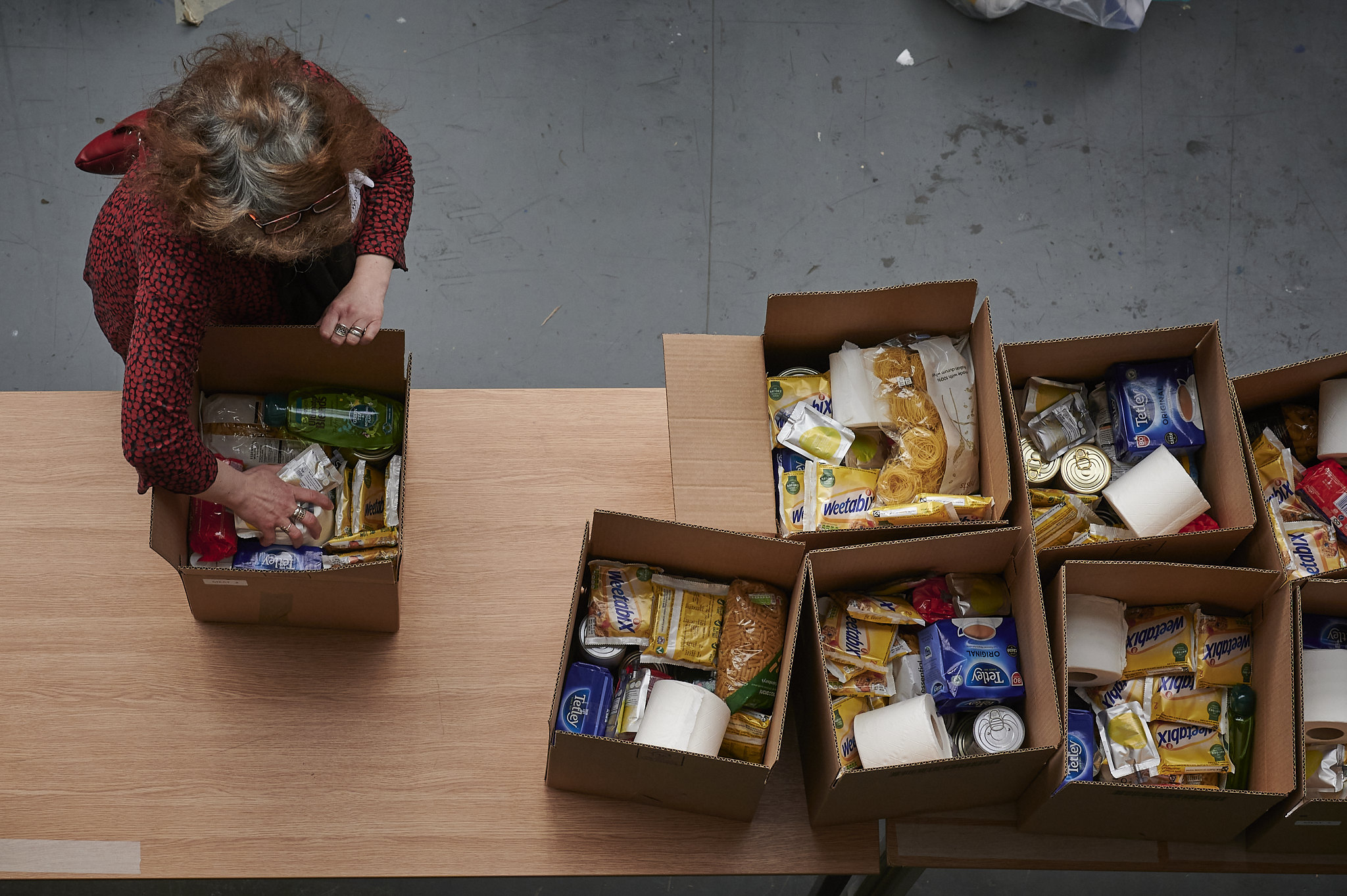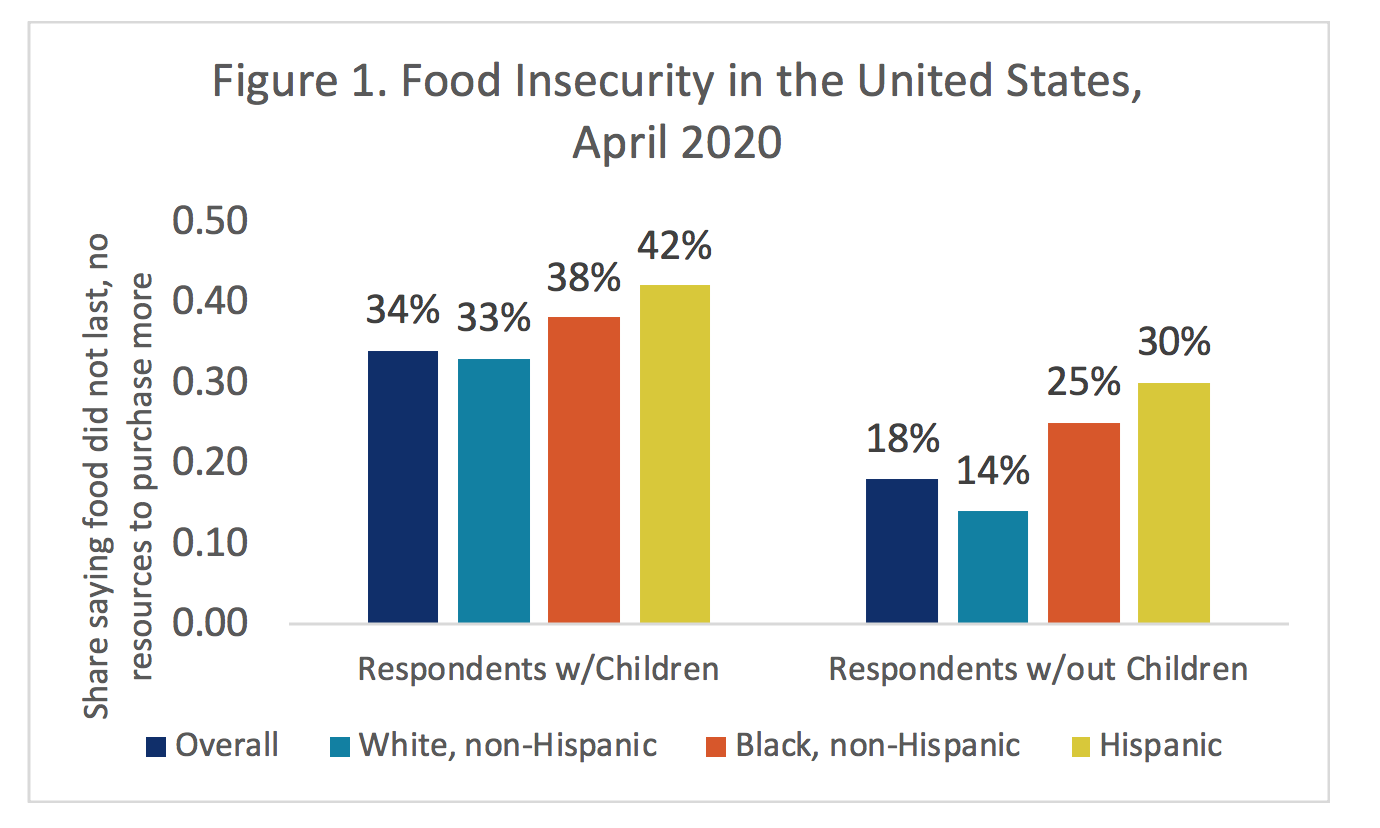Food Insecurity Triples for Families with Children During COVID-19 Pandemic
Data show nearly half worry they will run out of food and have no money for more
Get all our news

Food bank in Olympia, Washington.
The COVID-19 crisis has disrupted lives in a manner unprecedented in modern times, but for none more so than low-income working families with children. Unemployment has spiked sharply, and families have experienced income losses, increasing economic hardship. Compounding this loss of income, widespread physical school closings have meant that millions of children have lost access to subsidized school meals that play a key role in helping families with children meet their basic food needs.
New evidence is emerging from surveys since the COVID-19 pandemic began that document dramatic increases in food insecurity as well as very low food security—a more severe condition in which there have been substantial disruptions or reductions in food intake—among adults, children, and other vulnerable populations.
In their full report and appendix, IPR Director and economist Diane Whitmore Schanzenbach and research analyst Abigail Pitts take several approaches to contextualizing current levels of food insecurity in the United States:
- They analyze data from the COVID Impact Survey to describe levels of food insecurity by race, income, and presence of children in April 2020.
- They estimate the increase in food insecurity in April by comparing it to a similar measure of food insecurity that has been collected monthly from 2011–18 in nationally representative data. From this, they make projections about the likely rates of food insecurity on the eve of the COVID-19 crisis.
- They estimate how much of the increase in food insecurity experienced in April can be explained by the increase in that month’s unemployment rate. They find that the actual increase in food insecurity is substantially larger than what would have been predicted, especially among families with children.
- They describe self-reported use of emergency food assistance through food pantries.
- They provide estimates of food insecurity and food pantry use for states and metropolitan areas represented in the survey.

Schanzenbach and Pitts find sharp increases in food insecurity in April 2020 during the COVID-19 health emergency. Relative to predicted rates for March, in April food insecurity doubled overall and tripled among households with children. Food insecurity increased by more than April’s unemployment rate jump predicted it would, especially for families with children. They find that 7% of respondents overall, and nearly 20% of respondents who are experiencing food insecurity, reported receiving benefits from food pantries. But rates of food insecurity and interaction with food pantries varied widely across the states and metro areas.

The COVID Impact Survey collects data on economic and health outcomes of nationally and regionally representative samples of American adults. Funded by the Data Foundation, the survey is conducted by NORC at the University of Chicago and is made publicly available to researchers. In the primary analysis, they used the national sample and weights, which include data from 2,190 adults nationwide. Another 7,267 adults are surveyed in the subnational survey, which were used to provide representative estimates for 10 states and 8 metropolitan areas. The researchers used data from the first week of released data, collected between April 20–26. The second wave of the survey is expected to be released on May 14.
Estimates of Food Insecurity
Food insecurity is a measure that indicates that a household has experienced limited access to adequate food due to a lack of money and other resources. The USDA annually reports estimates of food insecurity in the United States calculated from the Current Population Survey’s Food Security Supplement (FSS). The most recently available data are from 2018.
The COVID Impact Survey asks respondents to indicate how often the two statements of food insecurity below were true of them or their households over the past 30 days:
- We worried our food would run out before we got money to buy more.
- The food that we bought just didn't last, and we didn't have money to get more.

Figure 1 (right) shows the share of respondents with and without children who reported food insecurity over the 30 days preceding their interview. Prior research has shown that households with children typically experience higher rates of food insecurity. During the COVID-19 pandemic, the loss of school meals has compounded this disadvantage. Within families, though, adults do their best to protect children from hunger by cutting their own food intake first. A recent survey found that 17% of mothers reported that their children were experiencing food insecurity. The level of children’s food insecurity is a little less than half of the rate of food insecurity in households that contain children. As shown in the bars on the left in Figure 1, more than 1 in 3 of households with children were food insecure, and approximately 2 in 5 black and Hispanic households with children were (orange and yellow bars).
Adding to the data above, Schanzenbach and Pitt included rates for respondents overall and rates of those responding that they were worried that their food would run out before they had money to purchase more. When they did, those without children reported lower rates of worry about food running out than those overall or with families. Higher shares of respondents answer affirmatively to the “worried” measure than the “didn’t last” measure. Overall, 28% of all respondents and 42% of those with children reported worrying about food running out. Over half of Hispanic respondents with children reported worrying that their food would run out.
How Much Did Food Insecurity Increase in April 2020?
To estimate the increase in food insecurity that has accompanied the COVID crisis, Schanzenbach and Pitts compare the April COVID Impact Survey estimates to a set of estimates and predictions from the National Health Interview Survey (NHIS), a monthly survey that collects data on a broad range of health topics. Their analysis indicates important differences in food insecurity across months, with it typically lowest in March, April, and May.
The table below (Table 2 in the full report) documents actual and predicted food insecurity for major racial/ethnic groups, with and without children.
- Column 1 presents April food insecurity rates from the COVID Impact Survey.
- Column 3 presents predicted food insecurity in March 2020 based on monthly unemployment and fixed effects.
- Column 4 presents the 2018 average food insecurity from the NHIS.
- Column 7 calculates the share of the observed increase in April that can be predicted by the model.
Before COVID-19, food insecurity was predicted to continue to fall across most groups, with the exception of Hispanics (for whom rates of unemployment had been already starting to increase).
However, food insecurity among those with children increased substantially more than what would be predicted based on the unemployment spike. Overall, April 2020 food insecurity for children is 40% higher than it was predicted to be. Across subgroups, the unexplained share of the increase in food insecurity ranges from 70% among whites with children to 12% among Hispanics with children. Some of the larger-than-predicted spike for those with children is likely explained by the loss of school meals. Since the COVID Impact Survey was conducted, there have been several policy responses that are expected to help address food insecurity among children. Future waves of the COVID Impact Survey will be able to measure to what extent food insecurity has stabilized or come down.
Table 2. Increase in Food Insecurity: Actual vs. Predicted, Various Models |
|||||||
|
|
Measured Food Insecurity, April 2020 |
Predicted Food Insecurity, April 2020 |
Predicted Food Insecurity, March 2020 |
Measured Food Insecurity, 2018 |
Increase: April 2020vs.Annual2018 |
Increase:April 2020vs.Predicted March |
Increase: April 2020vs.Predicted April |
(1) |
(2) |
(3) |
(4) |
(5) |
(6) |
(7) |
|
| Panel A: All Respondents | |||||||
| Overall | 22.8% | 18.1% | 10.1% | 10.7% | 213% | 226% | 126% |
| White | 18.2% | 14.5% | 7.2% | 7.7% | 237% | 252% | 126% |
| Black | 29.0% | 26.7% | 20.6% | 21.4% | 136% | 141% | 109% |
| Hispanic | 34.2% | 33.6% | 17.0% | 16.3% | 210% | 202% | 102% |
| Panel B: Respondents with Children | |||||||
| Overall | 34.5% | 24.4% | 11.6% | 12.3% | 280% | 297% | 141% |
| White | 32.9% | 19.4% | 8.7% | 9.1% | 360% | 376% | 170% |
| Black | 37.7% | 29.6% | 19.8% | 21.5% | 176% | 190% | 127% |
| Hispanic | 41.6% | 37.1% | 17.7% | 16.3% | 256% | 235% | 112% |
Food Insecurity and Food Pantry Interactions, by State and Metropolitan Area
The COVID Impact Survey also collected representative information for a select set of states and metropolitan areas. These data allowed the researchers to estimate rates of food insecurity and food pantry use for 10 states and 8 metropolitan areas. See Table 4 for the results.
Conclusion
The extent of economic distress experienced by families requires an urgent and sustained response from the federal government. Schanzenbach and Pitts plan to analyze food insecurity and related outcomes in future waves of the COVID Impact Survey to provide the evidence needed to track the evolution of both COVID-19’s impact on the population and the response of the public and private sectors.
Diane Whitmore Schanzenbach is the Margaret Walker Alexander Professor and IPR Director. Abigail Pitts is a research analyst. Read the complete report.
Photo credits: J. Thomas (top). J. Ziv (Schanzenbach)
Published: May 13, 2020.


